Perspectives on the History of Tarot
Tarot, originally a 15th century card game from Italy, has evolved into a form of personal mysticism and spiritual exploration, offering new visions of expanding awareness.

ITALY is said to be the birthplace of the tarot, along with Italian-suited playing cards. This is why most tarot decks have Italian suit symbols. According to playing-card historians tarot was originally a card game invented in the fifteenth century whose principal innovation was the introduction of trumps into card games. Helen Farley (2009) reckons that Duke Filippo Maria Visconti of Milan is "the most likely candidate for inventor of that first deck, sometime early in the fifteenth century". Thus the game of tarot uses an augmented deck (78 cards) of early Italian playing cards, born in a particular cultural milieu; southern Europe during the Middle Ages.
In the earliest surviving examples the order of the trump cards as well as their iconography and symbolism varies, reflecting the unfolding worldview of the Renaissance. (If tarot had been invented somewhere else, say in South America, then it might have been Inca or Mayan world view). The trump figures were understood as analogies of universal principles, depicting man's place in the cosmos and the divine order of things in the world of that time. Their imagery was not an integral part of how the game was played, but merely decorative, although there was an instructive or moralizing aspect to the imagery, perhaps aligned with the philosophical or spiritual yearnings of the Duke of Milan's élite circle. This made Tarot a form of cultural expression in itself: an identity statement.
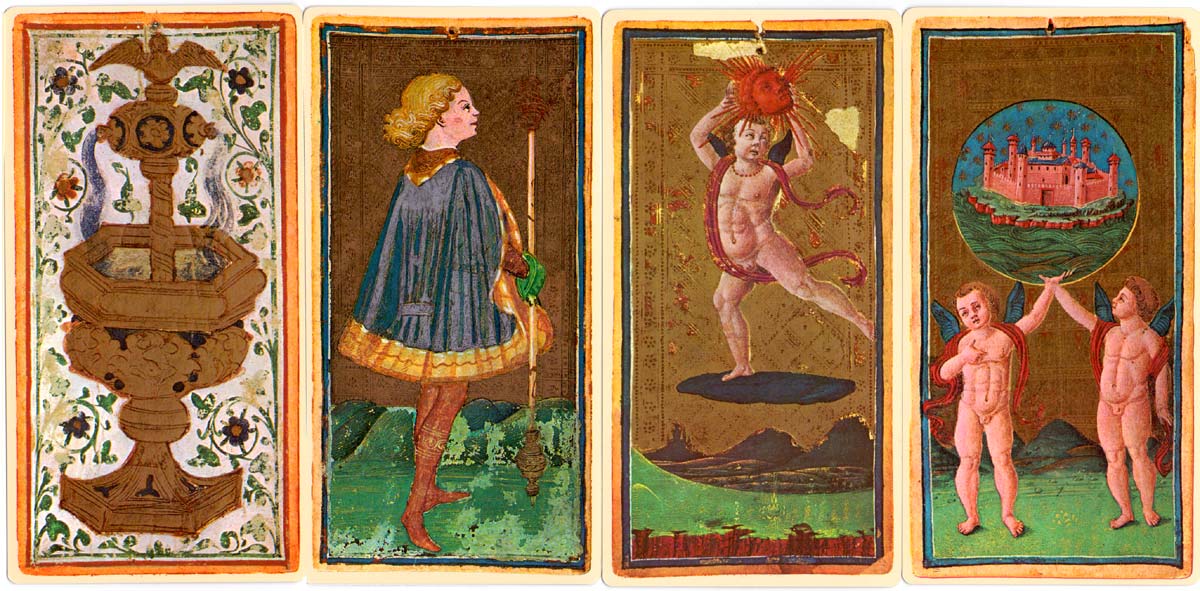
Above: the Visconti-Sforza Tarocchi, c.1460, produced for wealthy and status-conscious elites more →
Although the divinatory aspect of tarot didn't became popular until the 18th century, alchemical, astrological and hermetic imagery did appear in some earlier tarocchi decks because it was a part of the imaginary repertoire of the time. It is rewarding to investigate these mysteries for their own sake, but they were not necessarily intended to be part of the original game.
But there are some interesting exceptions in which the symbolism may constitute a metaphysical system. The Guildhall Library Tarocchi cards (shown below) believed to have been painted during the 15th century contain curious symbols and iconography. The knave of clubs shows a hunting scene, and in Platonic philosophy hunting was reckoned to develop moral strength and virility. The World card shows the New Jerusalem centered on the rebuilt Holy Temple. The black and white chequered floor tiles on the ace of cups, like in Masonic lodges, suggests the dualistic nature of the material realm upon which we must rebuild the spiritual life through practising higher moral virtues. The ace of swords (or Sun) suggests the idea that the endless cycles of birth and rebirth can be penetrated by spiritual wisdom. And we can also observe that the suit symbols were batons, cups, swords… and probably coins…
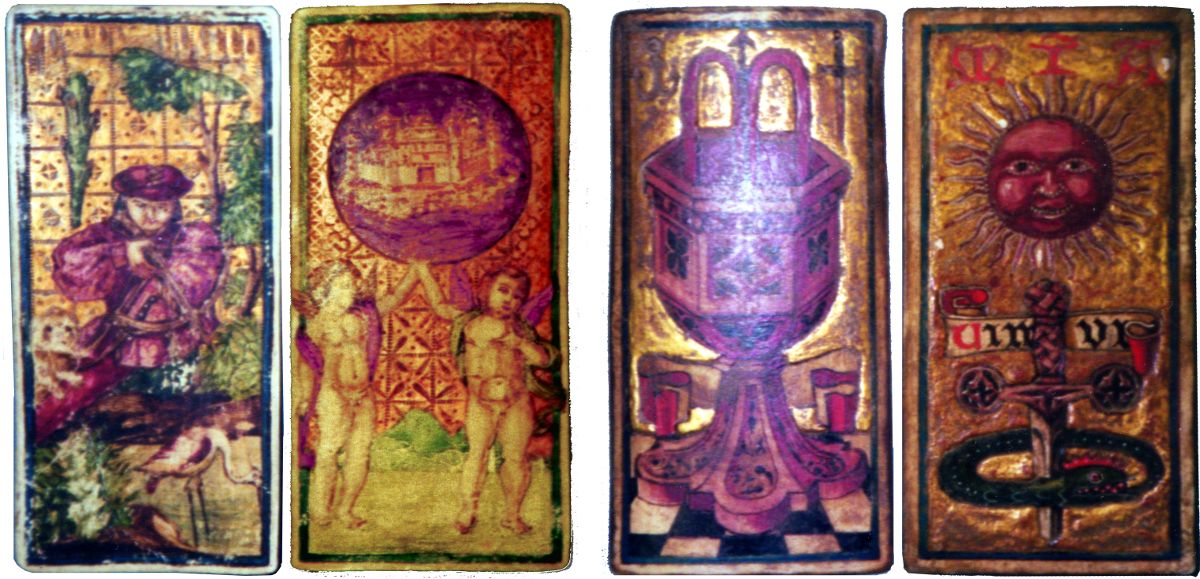
Above: the 4 "Guildhall Library Tarocchi Cards" from the Worshipful Company of Makers of Playing Cards collection of historic playing cards. Hand-painted and gilded by an illuminator, these cards are reckoned to be two pairs of cards from two different decks owing to differences in their size. The Guildhall catalogue records both pairs as having been found in an old chest in Seville (Spain). The Page of Batons has a Spanish-type club and is not holding his suit symbol as is common in all known Italian cards. The cards have no titles or numerals, so their sequence or hierarchy was presumably already known by the players. [Images by kind permission of the Worshipful Company of Makers of Playing Cards Collection and the London Metropolitan Archives, City of London Corporation]. Another similar example are the so-called 'Goldschmidt Cards' (a Google search will find some images. Also see Hoffmann, 1973).

Above: an interesting mix of intelletual influences can be seen in this late 15th century hand-painted tarot from Italy more →
-
From its early beginnings, it had the potential to serve as a tool for expressing identity politics and the philosophical yearnings of those who engaged with it, rather than being limited to ordinary playing cards.
The Sola Busca tarot could have constituted an alchemical guide to esoteric initiation for a secret society more →
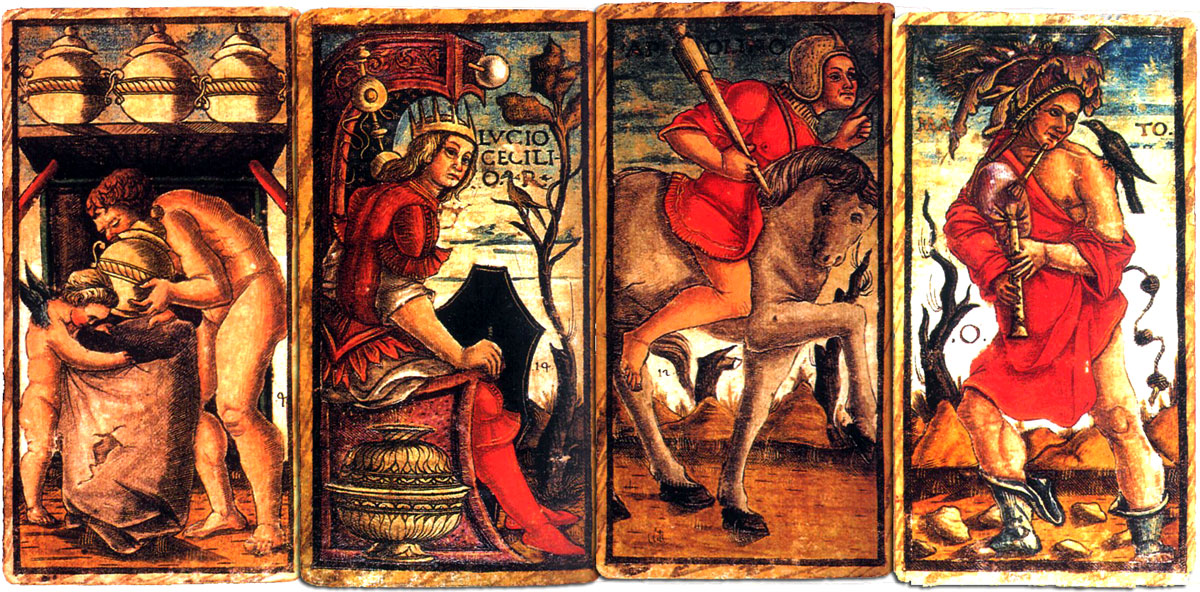
Above: four cards from the Sola-Busca Tarocchi, Ferrara, 1491 more →
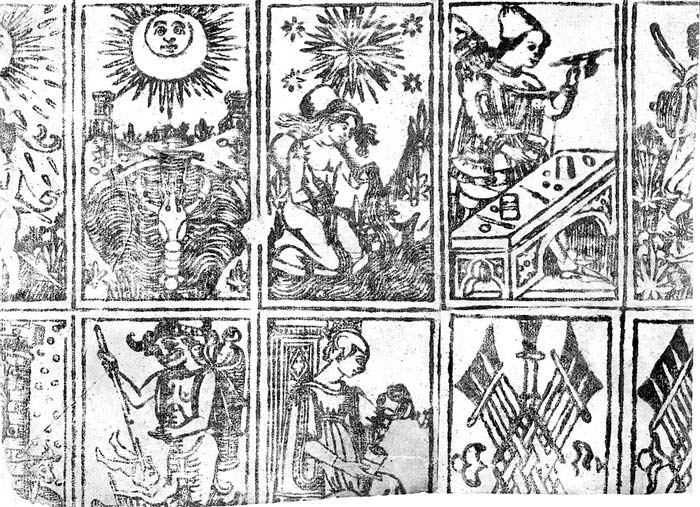
Above: detail from the Cary Collection uncut and uncoloured sheet of tarot cards (housed in the Beinecke Rare Book and Manuscript Library, Yale University in New Haven, Connecticut) probably printed in Milan and possibly dating as early as c.1500. The entire sheet is available for digital download here. The images are untitled and unnumbered, suggesting that players may have already known the sequence or hierarchy of trump cards in play from contemporary knowledge. Much of the imagery is recognisable as anticipating the more familiar Tarot de Marseille designs (see below) whilst other features are common to other early Italian decks such as the Visconti-Sforza and D'Este decks. Thus it looks like a prototype or intermediate form of the Tarot de Marseille design.
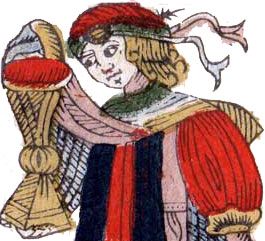
-
Tarot de Marseille
The game spread in Europe from Ferrara, Bologna and Milan towards Germany, Switzerland and France, where the Swiss Tarot and Tarot de Marseille were eventually born. The French word ‘tarot’ derives from the Italian ‘tarocco’. The Tarot de Marseille derives from the Milanese style of tarot, with the names of the court cards and trumps added at the bottom. It first began appearing in the mid 1600s. Speaking of the Tarot de Marseille, Alejandro Jodorowsky and Marianne Costa (2009) see the tarot as sacred art, like a Mandala (Yantra in Hinduism), in which all the individual symbols are part of the whole. Its meanings gradually reveal themselves to us, intuitively.


Above: the earliest known ‘Tarot de Marseille’ deck produced by Jean Noblet, Paris, c.1650.
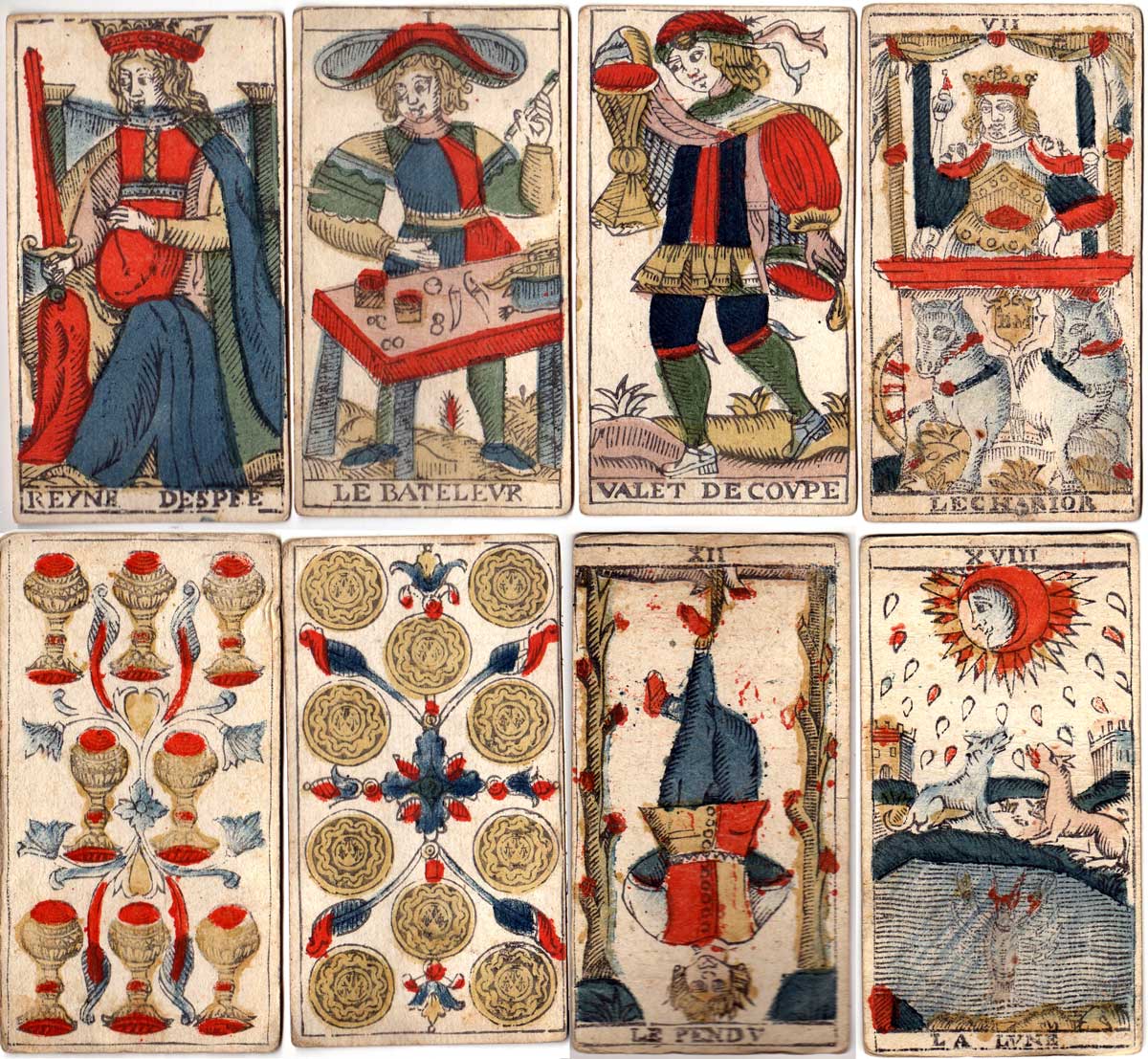
Above: Tarot de Marseille by Jean-Baptiste Madenié, Dijon, early 18th century. The page of cups holds his cup upwards, open to above, whilst the Magician also holds his wand aloft and the queen her sword. They all glance downwards. The trump cards are named and have Roman numerals to designate their value during play. Images courtesy Frederic C. Detwiller.
-
Animal and Mythological Tarots
By the mid 18th century Tarot packs with French suit signs were being produced in France, Austria, Switzerland and Germany with trumps displaying exotic animals, popular imagery, dancing, folklore, historical scenes - see examples. These were for playing the game of Tarock (not cartomancy or divination).
-
Egyptian Tarot
-
1750-1800: the occult and divinatory origin of Tarot - Antoine Court de Gébelin (1725-1784)
D
uring the later eighteenth century the Tarot was imbued with mystery by Antoine Court de Gébelin in vol.8 of his encyclopaedic work Monde Primitif, (1781). A theory is put forward of the philosophical and divinatory origins of the tarot including an association with ancient Egypt, and the idea of a past, idyllic or utopian civilisation. At this point the history of Tarot merges with the much older history of esoteric ideas, and interestingly, this confluence has evolved into the growing range of self-identity and multi-cultural tarots being published today.
Above: excerpt from Court de Gébelin's treatise Monde Primitif (volume 8, p.366, 1781), in which an exotic Egyptian origin is proposed for the allegorical images in the Tarot deck. At the end is a comparison with the invention of chess in India (6th century). Source: Internet Archive Monde Primitif vol.8

Above: six images from Court de Gébelin's treatise Monde Primitif (volume 8, p.720), Source: Internet Archive Monde Primitif vol.8
-
Etteilla - Jean-Baptiste Alliette (1738-1791)

Above: according to Etteilla: "There are two kinds of knowledge: one comes from experience and wisdom, and the other is natural intuition. Intuition is greater than all other human knowledge, except for the simple and wise belief in one God."
The first pack specifically intended for cartomantic use was that designed by Etteilla, engraved by Pierre-François Basan (1723-1797), hand-coloured and published in 1788 in the form of a tableau. It was a fantasy deck, radically different from the Tarot de Marseille published until then. There are basically three versions of this deck published subsequently. Grand Etteilla 1, most resembling the original, one of the earliest by Pierre Mongie L'Aine in 1826; Grand Etteilla 2 by Simon Blocquel in 1838 and Grand Etteilla 3 by De La Rue in 1867.
Etteilla was an algebra teacher. He also published a series of monographs on cartomancy and the Egyptian Book of Thoth from 1788 onwards, in which he attempted to clarify his ideas.

Above: Etteilla I Egyptian-inspired tarot published by Grimaud, Paris. Images courtesy of Adam West-Watson.
-
Eliphas Lévi (8 February 1810 – 31 May 1875)
Éliphas Lévi was another 19th-century French occultist who significantly influenced the development of modern Tarot through his esoteric writings. He linked the Tarot to the Kabbalah and the Hebrew alphabet (in addition to the Egyptian origin), proposing that the cards were not merely games or tools for divination, but a pictorial representation of the mysteries of human life and the universe. His work "Transcendental Magic" elaborates these ideas, which are foundational in shaping the mystical and symbolic interpretations of the Tarot that are popular today.
-
Papus (13 July 1865 – 25 October 1916)
Papus, the pseudonym of Gérard Encausse, was a pivotal figure in the late 19th and early 20th centuries in the field of Tarot and its esoteric study. He expanded on Éliphas Lévi's theories, further connecting Tarot cards with the Kabbalah and other mystical and occult traditions. His work, "The Tarot of the Bohemians", considered a seminal text on Tarot symbolism and its uses in divination, provided a comprehensive analysis of the Tarot, offering detailed interpretations of the cards and methods for using them in divination.
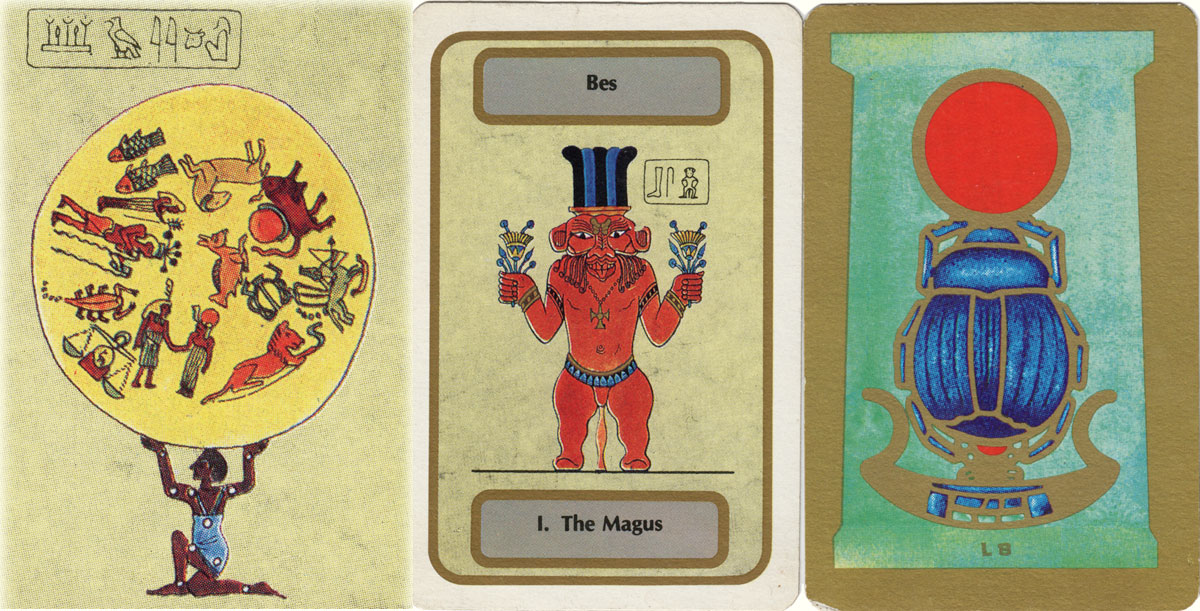
Above: fantasy Egyptian Tarot inspired by ancient Egyptian art, mythology and iconography, published by Naipes La Banca, Buenos Aires, c.1980.
To summarize: the 16th century had witnessed a renewed interest by scholars in classical history, along with the study of archaeology, philosophy, ancient religions, etc. This was accompanied by the publication of new treatises on all sorts of emerging scientific (and pseudo-science) subjects. The Romantic Movement gave rise during the 17th century to renewed interest in antiquarian topics (stonehenge, druids, etc) and has exercised a strange power over popular imagination ever since. The Occult Revivals and New Age Movement provided new cultural environments in which the tarot has evolved from its origins in medieval Italy into a vehicle for almost any form of philosophy or spiritual ideas. English occultists such as Aleister Crowley and A.E. Waite took all these developments in hand. Waite's tarot deck with artwork by Pamela Colman Smith includes illustrated numeral cards suitable for divination and this has become a template for many New Age tarot decks.
"The tarot embodies symbolical presentations of universal ideas, behind which lie all the implicits of the human mind..." A.E. Waite, The Pictorial Key to the Tarot, 1910.
-
Multidisciplinary Approach
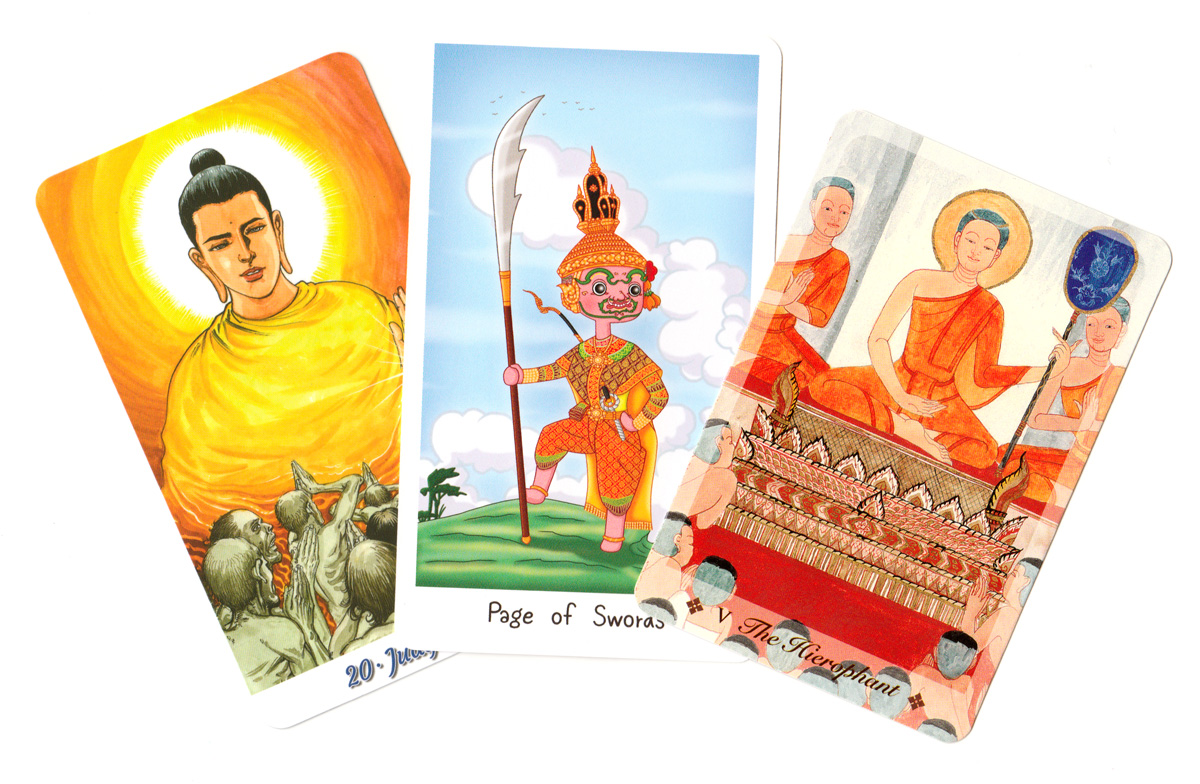
Above First Card: Judgement from the Thai Anatta Tarot showing a Buddha judging souls before they enter the afterlife.
Above Second Card: Page of Swords shown as a Thai Yak, or Giant Demons which play an important role within Thai mythology as well as Thai Buddhism.
Above Third Card: The Hierophant, sometimes refered to as the Pope, from the Siamese tarot, depicted as a Bodhisattva with 2 disciples.
Inspired by these early speculations, modern tarot packs now draw upon the teachings of a tremendous range of traditions, from Western esotericism and alchemy, Buddhism, Sufism and Egyptian initiations, to mystical Christianity, Gnosticism, Neoplatonism, Celtic mythology, Druidism… and so on (suggesting a common unity between them all). People have mapped whichever belief system or philosophy they fancy onto the tarot deck and then find they can quickly realise and develop an affinity with the symbolic images which become a source of meaning or guidance. It is now enjoying immense popularity in Far Eastern countries very distant from Western heritage (although many are following the Rider-Waite template).
For instance Thai tarot often features animist religious beliefs intermixed with Buddhism. Thai people believe that tarot can be used as a form of entertainment - they have a lot of fun with it. People think that's perfectly fine, they are using it in a positive way and not harming anyone. In Thai language people say they would "play tarot" the same way they "play Facebook".
Today's Tarot Studies come under a broad range of disciplines, the History of Art, Literature, Humanities and Cultural Studies headings. Many scholarly works are being produced. Topics range from historical studies and perspectives to practical interpretations of the cards, their images and symbolism. It has clearly become a multidisciplinary field.
-
Personal Mysticism and Spirituality
Tarot's widespread appeal stems from a desire to comprehend our role in the world without relying on religious institutions. Its imagery encompasses both ordinary life experiences and broader concepts of universal truth. By engaging with tarot symbolically, one can unlock fresh perspectives, gain new insights and spiritual clarity. It serves as a powerful tool for expanding understanding and delving deeper into the mysteries of existence.
A lot of pop culture tarot decks are appearing, based on video games, Disney or popular literature; Lord of the Rings, Game of Thrones, Dungeons & Dragons. It seems that reading tarot has also become a party trick. Licensed tarot decks are often tie-in merchandise for films, TV series or brands which you might just buy because you’re a fan, for fun, and try them. Branded decks are popular with young people who can connect more easily with the messages which are given by these brands (Disney, Games of Thrones, Cyberpunk 2077, etc), they are easier to interpret when compared to the traditional symbolism.
-
Identity Politics
Identity politics became a noticeable trend in the middle of the 20th century and gained attention within different social and political movements. Throughout history, these movements have advocated for civil rights, racial justice, feminism, gender equality, LGBTQ+ rights, disability rights, Native American rights, etc. They all worked towards securing rights and acknowledgment for their respective communities. In line with these movements, tarot has been reimagined and modified to align with the goals and interests of various groups. It has evolved to become a tool for exploring and expressing these new identities.

Above: your spiritual journey can include exploring intersex or gender fluid identities, experimenting with magic mushrooms or cannabis, having surreal imaginings or even a conventional virgin Mary vision. Each individual is unique and can define what spirituality means to them personally, without necessarily any outside institutions defining it for you. In certain periods, alternative spiritual beliefs were considered heretical and had to remain concealed. Tarot became part of a counter-culture that operated underground. However, in today's context, we embrace multiculturalism, allowing individuals the freedom to believe and practice as they choose. This openness has led to an abundance of diverse Tarot decks, reflecting the myriad perspectives and preferences of its practitioners.
We might surmise that many contemporary tarot packs are a sort of compendium of living experience, based on the artist’s creative and spiritual perspective of life. Modern tarot has also become part of the Western esoteric tradition and an effective divination technique that has roots in much older occult systems. [See Lewis Keizer, cited below]. Ultimately it is a question of what you want to believe…
There has also been a distinguished output of ENGLISH TAROT CARDS. By the 1870s a number of English occultists had begun taking an interest in the tarot more…
REFERENCES & RESOURCES
de Gébelin, Antoine Court, Monde Primitif, analysé et comparé avec le monde moderne (vol.8), Paris, 1781.
Dummett, Michael: A Brief Sketch of the History of Tarot Cards, The Playing-card, Journal of the IPCS, vol.33 no.4, Apr-June 2005.
Dann, Kevin Etteilla's Livre de Thot Tarot (ca.1789), The Public Domain Review, Oct 2022.
Etteilla: Collection précieuse des tableaux de la Doctrine de Mercure dans laquelle se trouve le chemin royal de la vie humaine, 1788, BnF.
Farley, Helen: A Cultural History of Tarot, published in 2009 by I.B.Tauris & Co Ltd.
Fontainelle, Earl: The Secret History of Western Esotericism►
Hunt, Ellie: When the mystical goes mainstream: how tarot became a self-care phenomenon►
Jodorowsky, Alejandro and Costa, Marianne: The Way of the Tarot, Destiny Books, 2009.
Keizer, Lewis: The Esoteric Origins of Tarot: more than a wicked pack of cards, included in The Underground Stream by Christine Payne Towler, Noreah Press, 1999. Can be found here►
Orsini, Julia; Lemarchand, Mlle; d'Odoucet, M. M.; Høgnesen, Marius (translator); The Grand Etteilla, self-published, 2021.
Penco, Carlo: Dummett and the Game of Tarot, Teorema, 2012
Poncet, Christophe: The Mysteries of the Tarot of Marseille, online: www.3x7.org►
Wintle, Prier: Attributes of the Egyptian Tarot: Attributes of the Egyptian Tarot►
Thanks to Samten de Wet for additional research and tarot material►

By Simon Wintle
Member since February 01, 1996
Founder and editor of the World of Playing Cards since 1996. He is a former committee member of the IPCS and was graphics editor of The Playing-Card journal for many years. He has lived at various times in Chile, England and Wales and is currently living in Extremadura, Spain. Simon's first limited edition pack of playing cards was a replica of a seventeenth century traditional English pack, which he produced from woodblocks and stencils.
Leave a Reply
Your Name
Just nowRelated Articles

Mountain Dream Tarot
Groundbreaking Tarot created by Bea Nettles, using photographs and photo montage.

Il Tarocco Mitologico
Fully pictorial Tarot designed by Amerigo Folchi with figures mainly from Greek mythology.

The Millenium Tarot: Tarot of the Four Worlds
First Australian Tarot, designed by Mary Susan Chamberlain, with artwork by Ziba Vilmanis-Westenberg...

Motherpeace Round Tarot
An original and imaginative feminist tarot based on Goddess energy.

Rouen Pattern - Portrait Rouennais
An attractive XV century French-suited design from Rouen became the standard English & Anglo-America...

Jeu de Tarot (Catel & Farcy)
Colourful version of a standard French (‘Bourgeois’) Tarot.

Paris 2024 Olympics 2
A standard French Tarot game pack with passing references to the Paris 2024 Summer Olympic Games.

Ganjifa - Playing Cards from India
Indian playing cards, known as Ganjifa, feature intricate designs with twelve suits and are traditio...

Tarot – Images du Pays Basque
Seventy-eight photographic images of the French Basque Country on a pack for playing the game of Tar...

The Henry Hart Puzzle
Explore the intricate history and unique design variations of Henry Hart's playing cards, tracing th...

A Million Dollar Tarot: The Alleyman’s Tarot
The Alleyman’s Tarot successfully raised $1,404,172 on Kickstarter. This unique 133-card deck includ...

Sevilla 1647 reproduction
Facsimile of Spanish-suited pack produced in Sevilla, Spain, 1647.

Quên Tarot
A mystical voyage of love and self-discovery created by Duy Khánh Võ.

Why our playing-cards look the way they do
Analysis of early playing card designs: origins, suit differences, standardization, technological ad...

Introduction to Collecting Themes
Playing cards can be broadly categorised into standard and non-standard designs, with collectors app...

Le Monde Primitif Tarot
Facsimile edition produced by Morena Poltronieri & Ernesto Fazioli of Museo Internazionale dei Taroc...
Trending Articles
Popular articles from the past 28 days



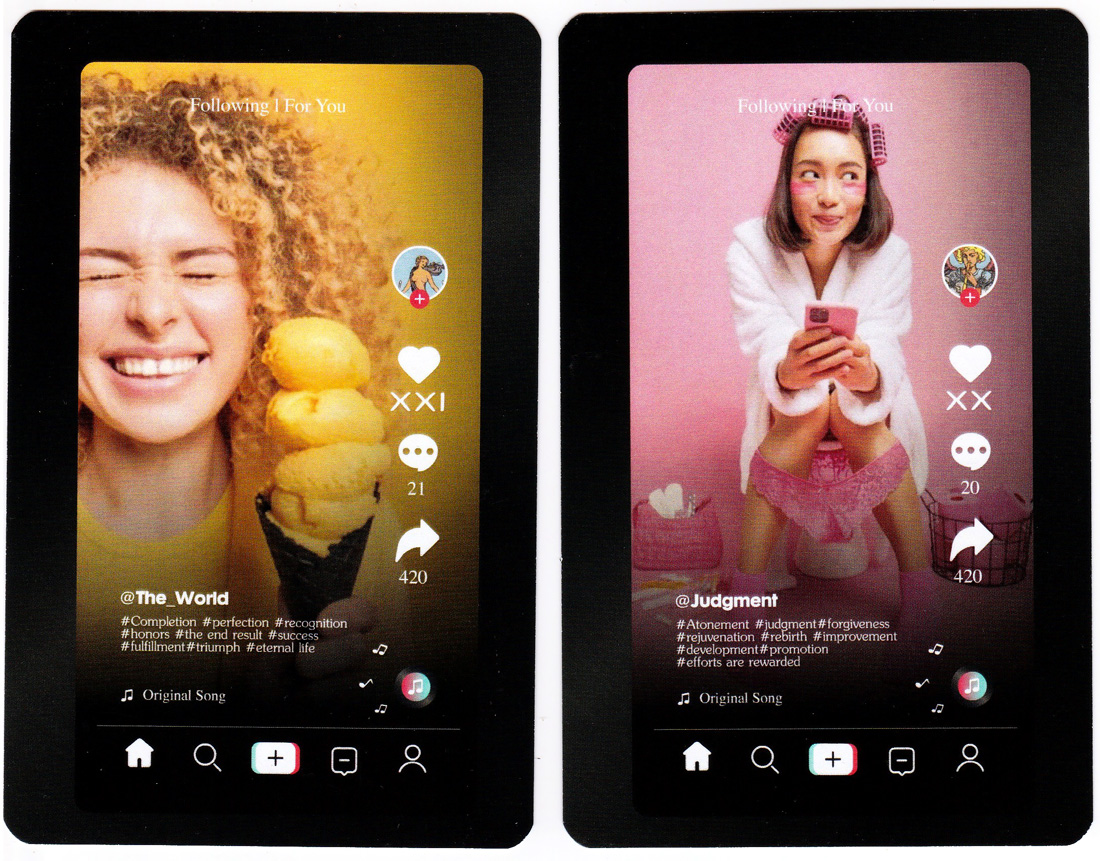


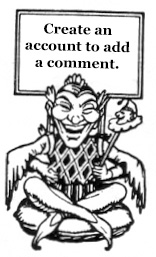 Your comment here. Your comment here. Your comment here. Your comment here. Your comment here. Your comment here. Your comment here. Your comment here. Your comment here. Your comment here. Your comment here. Your comment here. Your comment here. Your comment here. Your comment here. Your comment here. Your comment here. Your comment here. Your comment here. Your comment here. Your comment here. Your comment here. Your comment here. Your comment here. Your comment here. Your comment here. Your comment here. Your comment here. Your comment here. Your comment here. Your comment here. Your comment here.
Your comment here. Your comment here. Your comment here. Your comment here. Your comment here. Your comment here. Your comment here. Your comment here. Your comment here. Your comment here. Your comment here. Your comment here. Your comment here. Your comment here. Your comment here. Your comment here. Your comment here. Your comment here. Your comment here. Your comment here. Your comment here. Your comment here. Your comment here. Your comment here. Your comment here. Your comment here. Your comment here. Your comment here. Your comment here. Your comment here. Your comment here. Your comment here.